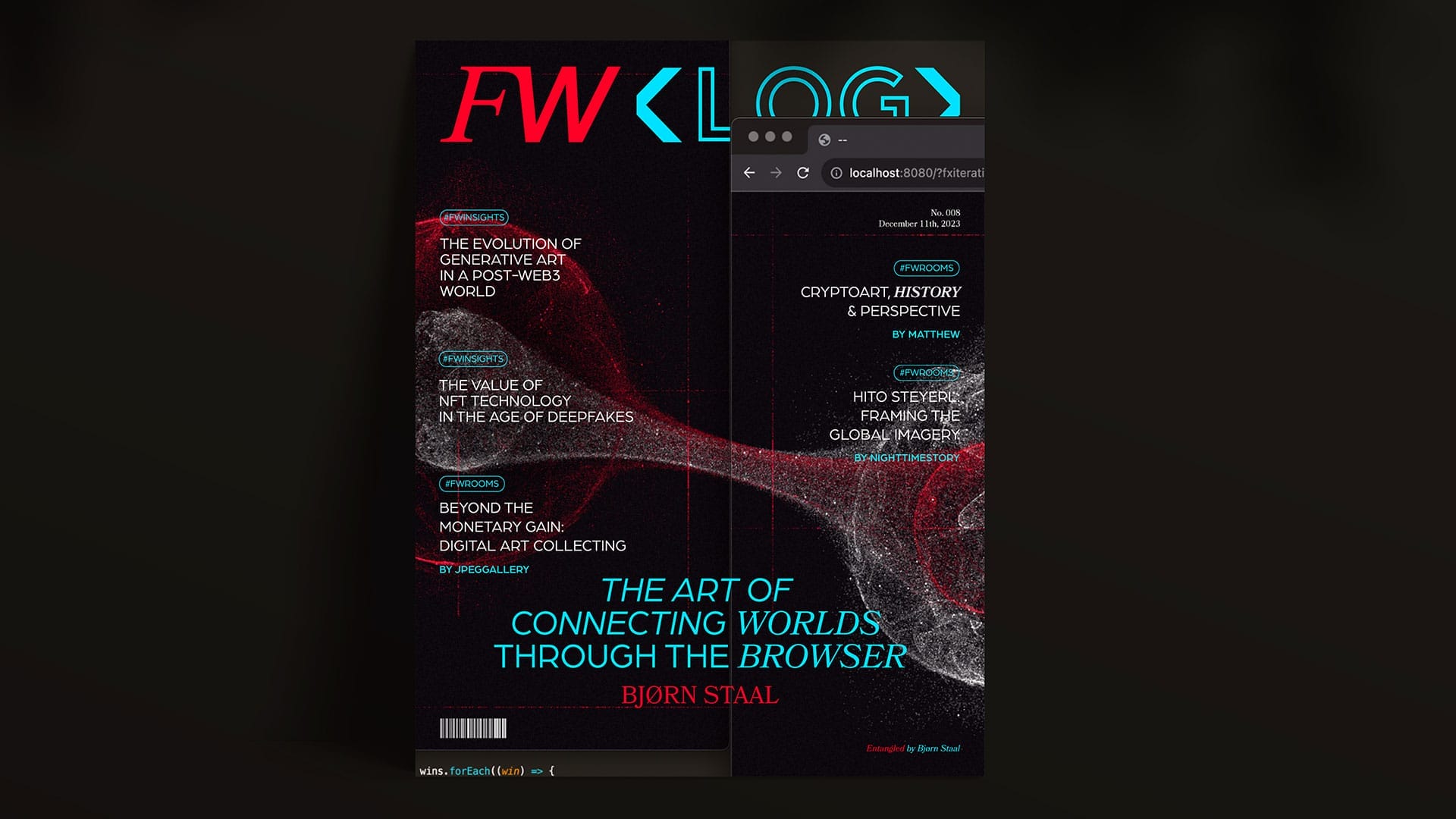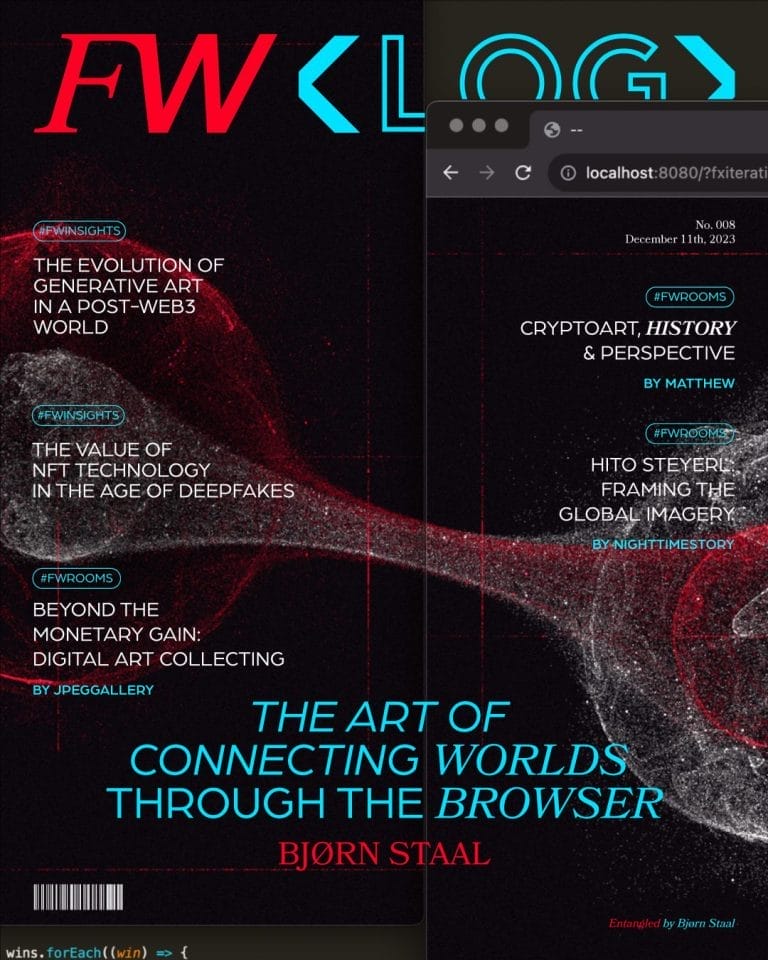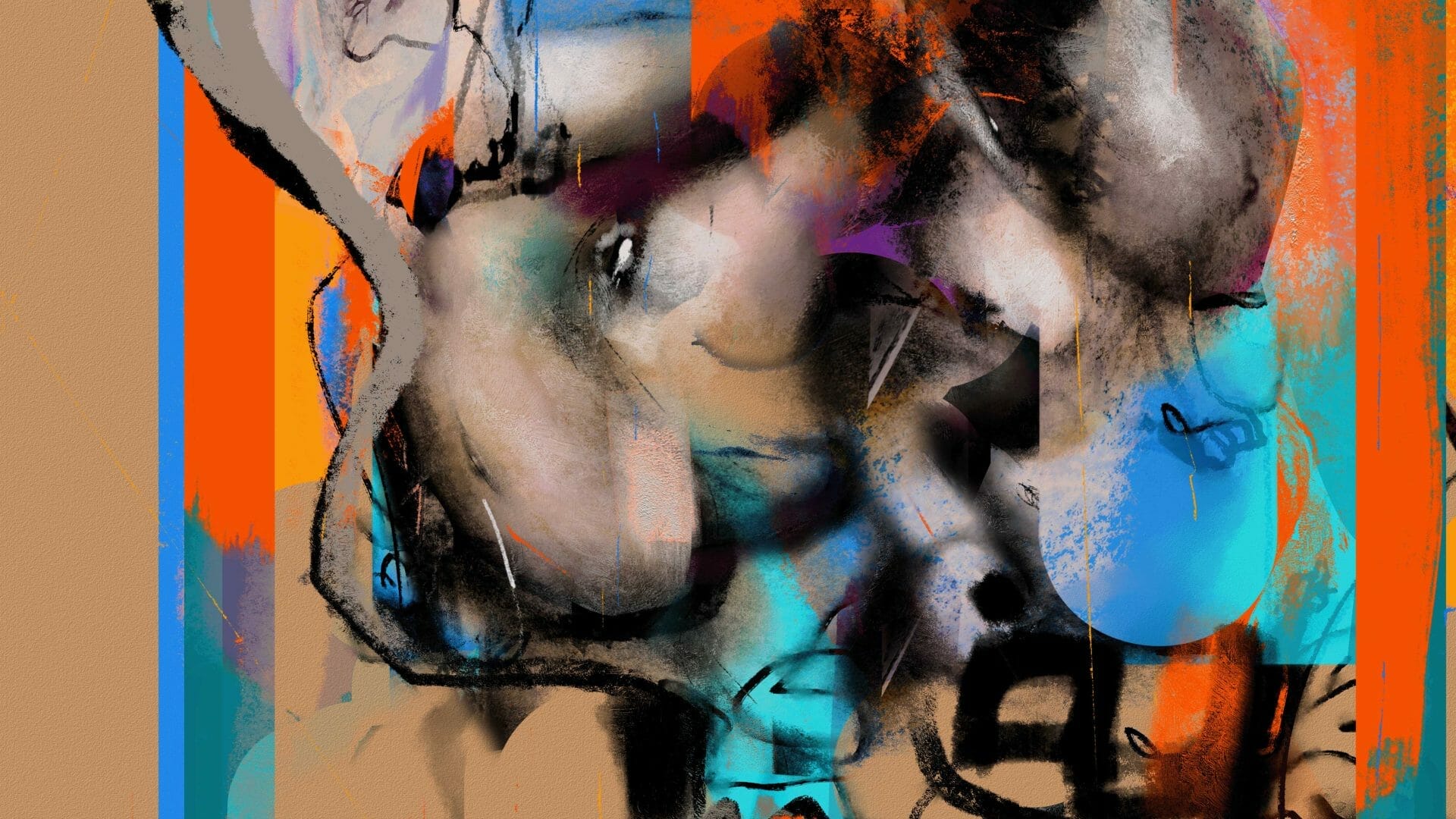
FW LOG: Editorial Feed No. 008
FW Editorial Feed No. 008 unfolds as a curated exploration of the evolving nexus between digital art, technology, and societal discourse.
This edition is exemplified by the generative work of Bjørn Staal on our FW Cover, which not only captures the thematic essence of our times but also embodies the holistic philosophical core of generative art. His work is a testament to the fusion of technology, creativity, and human experience, vividly demonstrating how beauty and complexity can emerge from the intricate interplay of coded rules, randomization, and interactivity.
Continuing on with Fakewhale Insights we further explore interactivity in a post-Web3 era, and the pivotal role of NFT technology in establishing digital authenticity amidst the rise of deepfakes.
In a seamless transition, we move to FW Rooms, where Matthew‘s detailed analysis provides a historical perspective on cryptoart, mapping out its evolution and potential future trajectory using Panter Xhita‘s “A HISTORY OF CRYPTOART” collection as a pivotal reference point. Following this, JPEGGALLERY‘s publication presents a compelling argument for reevaluating the motives behind collecting digital art, emphasizing its cultural and environmental implications beyond mere financial value. Concluding the edition, Nighttimestory‘s piece offers an in-depth critique of Hito Steyerl‘s work with an analysis that bridges the realms of art, technology, and political discourse.

In an insightful interview with Fakewhale, Bjørn Staal delves into the intricate balance of simplicity and complexity in his generative art, including insights into the narrative behind the viral work-in-progress ‘Entangled’. Staal’s profound understanding of generative algorithms and interactive, browser-based art forms elevates his work beyond mere visual appeal, emphasizing the contribution of open-source collaboration to today’s art forms. As he discusses his upcoming project ‘Immaterial’, Staal offers a glimpse into his vision, where art and technology seamlessly blend, redefining the parameters of artistic expression.
In the post-Web3 era, generative art undergoes a transformative fusion of blockchain technology and creative coding, creating immersive, interactive experiences. This shift from passive viewing to active participation revolutionizes the artist-audience relationship. Generative art, rooted in the mid-20th century, now leverages modern programming languages for complex algorithm-driven artworks. This evolution heralds a new era of digital creativity, where code and audience interplay introduces unprecedented interactivity in art forms. This article explores generative art’s historical journey and its current state as a living entity, reflecting the intricate relationship between technology, artists, and audiences.
In a time marked by digital manipulation, where deepfakes blur reality and fabrication, NFT technology plays a crucial role in embedding authenticity into digital media. Deepfakes, characterized by hyper-realistic alterations, have become tools for disinformation. In response, NFTs present a powerful countermeasure, leveraging blockchain technology to ensure digital media integrity. This article examines the origins of NFT technology and its evolution, emphasizing its role as an artistic innovation and vital response to a crisis of digital authenticity by contrasting deepfakes’ deceptional potential with NFTs’ protective capabilities.
In Matthew’s newest FW ROOMS publication, the journey of cryptoart from inception to its current state is vividly depicted, capturing the kinetic energy powering a tidal wave of artists and collectors globally. The article reflects on the growing movement, highlighted by Panter Xhita’s “A HISTORY OF CRYPTOART”, showcasing 90 artists’ portraits in Mexican muralism style — a collection capturing the current state of this rapidly evolving art form, underscoring the resilience and diversity of the cryptoart world. Ultimately, this piece underscores the vital role of artists in providing visual and contextual perspectives, chronicling the cryptoart space’s evolution from digital pioneers to a thriving digital metropolis.
JPEGGALLERY reexamines the practice of collecting art in the digital age, moving beyond traditional financial motivations. On the other hand, he emphasizes the cultural and societal impact of embracing digital art, arguing for its role in preserving contemporary cultural narratives and supporting artistic innovation. To conclude, he highlights the eco-friendly aspect of digital art and its contribution to challenging traditional artistic norms, framing the act of collecting digital art as a cultural statement reflecting a commitment to innovation, inclusivity, and recognition of art as a vital component of digital cultural heritage.
Hito Steyerl, a profound figure in contemporary art, embodies the intersection of art, technology, and political critique, transcending mere visual representation with rich socio-political commentary. As analyzed in Nighttimestory’s article, her work challenges viewers to scrutinize authenticity in images and narratives, integrating advanced digital elements that question technology’s omnipresence in modern life. Steyerl’s politically charged art reflects her commitment to exploring global society’s power dynamics, rendering her creations not just aesthetically striking but also intellectually stimulating.
fakewhale
Founded in 2021, Fakewhale advocates the digital art market's evolution. Viewing NFT technology as a container for art, and leveraging the expansive scope of digital culture, Fakewhale strives to shape a new ecosystem in which art and technology become the starting point, rather than the final destination.
You may also like
Curator Spotlight #5: Cao Shu
In this fourth chapter of our Curator Spotlight series, we continue our journey through the evolving
Ju Young Kim, Aeroplastics at Academy of Fine Arts in Munich, Munich
“Aeroplastics” by Ju Young Kim, at Academy of Fine Arts in Munich, Munich, 8/02 –
Kazuhiro Aihara: Uncharted Pixels
Kazuhiro Aihara is a Japanese digital artist who explores original digital textures, brushstrokes, a










